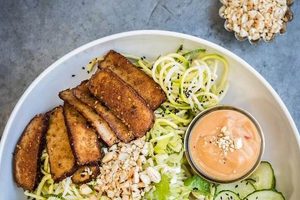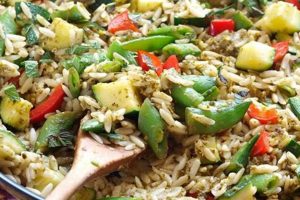A culinary preparation designed to complement fresh fruit, this item is characterized by its formulation without animal-derived ingredients. It provides a sweet and creamy accompaniment intended for dipping various fruits such as strawberries, apples, and bananas. As an example, a common preparation might involve blending cashews, plant-based milk, and natural sweeteners.
The significance of this specialized recipe lies in its accessibility for individuals adhering to vegan diets or those with dairy sensitivities. It offers a versatile and flavorful alternative to conventional dairy-based dips, promoting inclusive consumption and expanding options for healthy snacking and dessert courses. Its increasing popularity reflects a broader trend toward plant-based eating and mindful dietary choices.
The subsequent sections will detail the fundamental components necessary for its creation, diverse preparation methodologies, and suggestions for flavor augmentations. Furthermore, information regarding storage protocols and serving recommendations will be provided to optimize the culinary experience.
Preparation and Enhancement Techniques
The following guidelines are designed to improve the quality and appeal of the final product, ensuring a palatable and aesthetically pleasing outcome.
Tip 1: Ingredient Selection: Prioritize high-quality, ripe fruits and fresh ingredients. The flavor profile of the dip is significantly influenced by the quality of its components. For example, using high-quality vanilla extract will offer a richer taste than imitation vanilla.
Tip 2: Cashew Soaking Protocol: Cashews are frequently employed as a base for creamy textures. Soaking cashews in hot water for a minimum of 30 minutes, or preferably overnight in cold water, softens them and facilitates smoother blending. This step is crucial for achieving a silky consistency.
Tip 3: Sweetener Regulation: Exercise judicious control over the amount and type of sweetener used. Natural sweeteners like maple syrup, agave nectar, or dates provide sweetness without the refined sugar found in conventional options. Begin with a small quantity and gradually increase until the desired sweetness is attained.
Tip 4: Flavor Infusion: Introduce complementary flavors to elevate the taste profile. Citrus zest, such as lemon or orange, provides brightness and complexity. Spices like cinnamon or nutmeg add warmth and depth.
Tip 5: Consistency Management: Adjust the liquid content to achieve the preferred consistency. Plant-based milk, such as almond or soy milk, can be added incrementally to thin the dip. For a thicker consistency, consider adding a small amount of tapioca starch.
Tip 6: Chilling and Maturation: Allow the prepared dip to chill in the refrigerator for at least 30 minutes before serving. Chilling allows the flavors to meld and the texture to firm, enhancing the overall sensory experience.
Tip 7: Serving Presentation: Serve the dip in an aesthetically pleasing manner. Garnish with fresh fruit, a sprinkle of nuts, or a dusting of cocoa powder. A visually appealing presentation enhances the perceived quality and desirability of the product.
Adhering to these guidelines results in a flavorful, texturally appealing, and visually attractive accompaniment to fresh fruit. Proper execution ensures that the recipe serves as a delightful and nutritious addition to any meal or gathering.
The ensuing section will address variations on the core recipe, exploring diverse flavor profiles and ingredient substitutions.
1. Creamy cashew base
The creamy cashew base is a fundamental component in many vegan fruit dip formulations. This is due to the cashew’s inherent ability to, when processed correctly, mimic the texture and mouthfeel of dairy-based cream. The cause-and-effect relationship is straightforward: properly prepared cashews, when blended, yield a smooth and rich consistency, directly contributing to the desired creamy texture of the final product. Without a suitably creamy base, a plant-based fruit dip will lack the characteristic appeal of its conventional counterpart. A real-life example is evident in countless vegan cookbooks and online recipes, where soaked and blended cashews are routinely cited as the primary ingredient for achieving creaminess in desserts and dips. The practical significance of this understanding is that it allows individuals seeking to create vegan alternatives to successfully replicate the textures they desire, enhancing the palatability and acceptability of plant-based options.
Further analysis reveals that the preparation method of the cashew base significantly impacts the overall result. Soaking the cashews, as previously noted, is paramount. The soaking process hydrates the nuts, softening them and facilitating a smoother blend. Failure to adequately soak the cashews will result in a grainy or gritty texture, negatively affecting the final dip’s quality. Moreover, the blending process itself is crucial. A high-powered blender is generally required to achieve the desired smoothness. Some recipes also incorporate ingredients like coconut cream or plant-based yogurt to further enhance the creaminess and add complexity to the flavor profile. A practical application of this is seen in commercially produced vegan dips, where manufacturers often utilize specialized equipment and techniques to optimize the cashew base’s texture and stability.
In conclusion, the creamy cashew base is not merely an ingredient but a cornerstone of successful vegan fruit dip recipes. The understanding of its properties and preparation requirements is essential for achieving the desired texture and flavor. While challenges may exist in consistently producing a perfectly smooth result, mastering the basics of cashew preparation opens the door to a wide range of delicious and satisfying plant-based alternatives. This understanding links directly to the broader theme of vegan cuisine, where innovative uses of plant-based ingredients are constantly evolving to create familiar and appealing food experiences.
2. Natural sweetener source
The selection of a natural sweetener source is directly linked to the overall healthfulness and flavor profile of a vegan fruit dip recipe. Traditional refined sugars are avoided in favor of options such as maple syrup, agave nectar, dates, or fruit purees. The impact of this choice is multifaceted: it reduces the glycemic load, provides additional micronutrients, and imparts unique flavor characteristics to the final product. A key reason natural sweeteners are used is the growing awareness of the detrimental health effects associated with processed sugars. A practical example is the substitution of cane sugar with date paste, providing sweetness alongside fiber and antioxidants. This highlights the importance of ingredient selection in health-conscious culinary applications.
Further analysis reveals that different natural sweeteners contribute distinct flavor notes. Maple syrup offers a caramel-like undertone, agave provides a cleaner sweetness, and dates impart a richer, more complex flavor. The choice depends on the desired taste profile of the fruit dip and the complementary relationship with the fruits being served. For instance, a dip intended for tart berries might benefit from the deeper sweetness of dates, while a lighter-flavored fruit salad might pair better with agave’s neutrality. In the realm of commercial production, the consistency and stability of the natural sweetener are also crucial considerations. Liquid sweeteners might require adjustments to maintain the desired dip consistency, highlighting the need for careful recipe formulation.
In conclusion, the selection of a natural sweetener source is not merely a substitution but a conscious decision to enhance the nutritional value and flavor complexity of vegan fruit dip recipes. While challenges exist in achieving the same level of sweetness as refined sugars with some natural alternatives, the benefits outweigh the drawbacks for many health-conscious consumers. This choice exemplifies a broader trend in culinary practices towards utilizing whole, unprocessed ingredients to create healthier and more flavorful dishes.
3. Flavor profile diversity
Flavor profile diversity is a pivotal element in the successful execution of a vegan fruit dip recipe. The absence of dairy necessitates strategic incorporation of flavorings to compensate for the richness and complexity typically provided by animal products. This diversity is not merely aesthetic; it directly influences the palatability and consumer appeal of the final product. The inclusion of diverse flavors compensates for the missing dairy components, offering complexity and depth. A bland dip, lacking in flavor diversity, is likely to be unappetizing and fail to satisfy consumers accustomed to traditional, dairy-based alternatives. The practical significance of this understanding lies in the ability to craft a product that is not only vegan but also comparable, or even superior, in taste and overall sensory experience to its conventional counterpart.
Further analysis reveals various approaches to achieving flavor profile diversity. Citrus zest, such as lemon or orange, introduces brightness and acidity, contrasting the sweetness of the fruit and dip. Spices, including cinnamon, nutmeg, or ginger, add warmth and depth, particularly effective in dips intended for fall or winter seasonal fruits. Extracts, such as vanilla or almond, provide aromatic complexity, enhancing the overall sensory experience. Moreover, the use of different nut butters, beyond cashews, such as almond or peanut butter, contributes unique flavor profiles and textures. As an example, a vegan fruit dip incorporating peanut butter, cocoa powder, and maple syrup offers a dessert-like indulgence, appealing to consumers seeking richer flavor experiences. The choice of flavorings must also consider the intended pairing with specific fruits, creating harmonious flavor combinations.
In conclusion, the importance of flavor profile diversity in a vegan fruit dip recipe cannot be overstated. While challenges exist in replicating the inherent flavor of dairy products, the strategic use of complementary ingredients and flavorings allows for the creation of a complex, satisfying, and appealing plant-based alternative. This understanding underscores the broader principle of innovation and creativity in vegan cuisine, demonstrating that the absence of animal products does not equate to a sacrifice in taste or sensory appeal.
4. Ingredient substitutions
Ingredient substitutions are integral to the successful formulation of a vegan fruit dip recipe. The absence of animal-derived products necessitates the replacement of conventional ingredients like dairy-based cream cheese, sour cream, or heavy cream with plant-based alternatives. The direct effect of these substitutions is the creation of a dip suitable for individuals adhering to vegan dietary guidelines. Without strategic ingredient substitutions, a fruit dip cannot be considered vegan. For instance, replacing cow’s milk with almond milk transforms a potentially non-vegan recipe into a plant-based dish. This ability to modify recipes expands dietary options and promotes inclusivity.
Further analysis demonstrates the diversity of available substitutions and their impact on the final product’s flavor and texture. Cashews, when soaked and blended, can mimic the creamy consistency of dairy. Coconut cream offers richness and a subtle tropical flavor. Silken tofu provides a smooth texture with a neutral taste, allowing other flavorings to dominate. The practical application of these substitutions is evident in countless vegan recipes, where combinations of plant-based ingredients are employed to replicate the desired characteristics of traditional dishes. This exemplifies the adaptability and resourcefulness inherent in vegan culinary practices. For example, using a combination of soaked cashews and coconut cream yields a particularly rich and decadent dip.
In conclusion, ingredient substitutions are not merely optional modifications but essential components of a vegan fruit dip recipe. The careful selection and utilization of plant-based alternatives enable the creation of a palatable and satisfying dip that aligns with vegan dietary principles. While challenges may exist in perfectly replicating the flavor and texture of dairy-based products, the variety of available substitutions allows for significant creativity and customization, ultimately broadening the appeal and accessibility of plant-based cuisine.
5. Consistency regulation
Achieving the desired consistency is paramount to the overall palatability and consumer acceptance of any fruit dip, particularly within the realm of vegan formulations. The absence of traditional dairy-based thickeners and stabilizers necessitates a deliberate approach to manage the texture and viscosity of the final product.
- Liquid-to-Solid Ratio Adjustment
Controlling the ratio of liquid ingredients (e.g., plant-based milk, fruit purees) to solid components (e.g., soaked cashews, silken tofu) directly influences the dip’s thickness. Excessive liquid results in a runny consistency, while insufficient liquid yields a thick or pasty texture. Fine-tuning this ratio is crucial for achieving the desired spreadability and mouthfeel. For example, adding small increments of almond milk allows for precise control over the dip’s fluidity.
- Thickening Agents Incorporation
Plant-based thickening agents such as cornstarch, tapioca starch, or arrowroot powder can be employed to enhance viscosity. These starches, when heated, gelatinize and create a thicker texture. Proper dispersion of the starch is essential to prevent clumping. A slurry of starch and cold water should be added to the dip while simmering gently to ensure even thickening. The amount of thickening agent used directly impacts the dip’s final consistency; excessive use can result in a gummy texture.
- Temperature Influence
Temperature plays a significant role in the consistency of vegan fruit dips. Chilling the dip after preparation allows the ingredients to further thicken and meld, resulting in a firmer texture. Conversely, excessive heat during preparation can cause some plant-based ingredients to break down or separate, negatively affecting the consistency. Refrigerating the dip for at least 30 minutes before serving is often recommended to achieve optimal texture.
- Ingredient Emulsification and Stabilization
Proper emulsification of fats and liquids is essential for creating a smooth and stable consistency. Ingredients like coconut cream or nut butters, which contain significant fat content, must be thoroughly blended with the liquid components to prevent separation. Stabilizers such as lecithin or xanthan gum can be added to maintain emulsion stability over time, particularly in commercially produced vegan fruit dips. These stabilizers prevent the dip from separating into layers, ensuring a consistent texture throughout its shelf life.
These facets highlight the nuanced approach required to achieve optimal consistency in a vegan fruit dip. Careful consideration of ingredient ratios, thickening agents, temperature control, and emulsification techniques is essential for creating a palatable and visually appealing product. Failure to effectively regulate consistency can result in a dip that is either unappetizingly thin or unpleasantly thick, thus impacting the overall enjoyment and acceptance of the recipe.
6. Refrigeration's importance
Refrigeration is a critical factor in the preservation, texture, and overall quality of vegan fruit dip recipes. Its role extends beyond simple temperature control; it directly influences the safety, palatability, and longevity of the product, particularly given the absence of traditional dairy-based preservatives.
- Microbial Growth Inhibition
Refrigeration significantly retards the growth of spoilage microorganisms such as bacteria, yeasts, and molds. Vegan fruit dips, often based on ingredients like cashews or tofu, provide a nutrient-rich environment conducive to microbial proliferation. Maintaining a consistent cold temperature (typically below 40F or 4C) slows down metabolic activity, thereby extending the shelf life of the dip and reducing the risk of foodborne illness. An example is the delayed spoilage of a cashew-based dip kept refrigerated versus one left at room temperature, where souring or mold growth would occur much more rapidly.
- Texture Enhancement and Stabilization
Refrigeration promotes a firmer and more desirable texture in many vegan fruit dips. Cooling allows the ingredients to fully hydrate, meld together, and achieve a thicker consistency. For instance, dips containing starches or gums as thickening agents often require refrigeration to fully activate their gelling properties. Furthermore, refrigeration helps stabilize emulsions, preventing the separation of oil and water components. This is particularly important in dips containing coconut cream or nut butters, which can separate at warmer temperatures.
- Flavor Development and Integration
Refrigeration facilitates the melding of flavors within the vegan fruit dip. As the dip sits at a low temperature, the various flavor compounds interact and harmonize, resulting in a more cohesive and balanced taste profile. This process allows for the subtle nuances of spices, extracts, and sweeteners to fully develop and integrate into the overall flavor. A newly made vegan fruit dip may taste noticeably different after several hours of refrigeration, as the flavors have had time to fully combine.
- Prevention of Oxidation and Discoloration
Refrigeration slows down the rate of oxidation, which can lead to undesirable changes in color and flavor. Many fruits and some vegan dip ingredients, such as avocados, are prone to enzymatic browning when exposed to air. Lowering the temperature reduces the activity of the enzymes responsible for this browning, preserving the dip’s visual appeal and preventing off-flavors from developing. An example is a lemon juice-containing fruit dip which, when properly refrigerated, avoids discoloration.
In summary, refrigeration is indispensable for maintaining the quality, safety, and palatability of vegan fruit dip recipes. By inhibiting microbial growth, enhancing texture, promoting flavor integration, and preventing oxidation, refrigeration ensures that the dip remains a delicious and visually appealing accompaniment to fresh fruit. Adherence to proper refrigeration protocols is essential for both home cooks and commercial producers seeking to create a safe and high-quality vegan product.
Frequently Asked Questions
This section addresses common inquiries related to the preparation and properties of plant-based fruit dips.
Question 1: What is the typical shelf life of a vegan fruit dip?
Refrigerated vegan fruit dips generally remain consumable for three to five days. Specific shelf life depends on ingredients and storage conditions; proper refrigeration is critical.
Question 2: Can a vegan fruit dip be frozen for extended storage?
Freezing is generally not recommended, as it can alter the texture and consistency of many plant-based dips. Thawing may result in a grainy or watery product.
Question 3: How can the sweetness of a vegan fruit dip be adjusted?
Sweetness can be modified by adjusting the quantity of natural sweeteners, such as maple syrup or agave nectar. The addition of acidic ingredients, like lemon juice, may also balance the sweetness.
Question 4: What are suitable substitutions for cashews in a vegan fruit dip?
Alternatives include silken tofu, sunflower seeds, or white beans. These ingredients require proper preparation to achieve a smooth texture.
Question 5: How can a grainy texture be avoided in a cashew-based vegan fruit dip?
Adequate soaking of the cashews is paramount. Soaking for at least four hours, or preferably overnight, ensures a smoother consistency when blended.
Question 6: Is it possible to create a vegan fruit dip without nuts?
Indeed. A nut-free recipe can utilize a base of silken tofu or sunflower seed butter, carefully adjusting other ingredients to achieve the desired flavor and texture.
Proper preparation and storage protocols are vital for maximizing the enjoyment and safety of a plant-based fruit dip.
The subsequent section will provide innovative recipe variations and creative serving suggestions.
Conclusion
This exploration of the vegan fruit dip recipe has detailed its components, preparation nuances, and considerations for optimal flavor and texture. From ingredient selection to the importance of refrigeration, each element plays a critical role in the final product’s success. Understanding these aspects allows for informed culinary decisions and consistent results.
The vegan fruit dip recipe represents a versatile option for those seeking plant-based alternatives. Continued experimentation with flavor combinations and ingredient substitutions will further refine its appeal and accessibility within a diverse range of culinary applications. The pursuit of excellence in plant-based cuisine remains a worthwhile endeavor.







